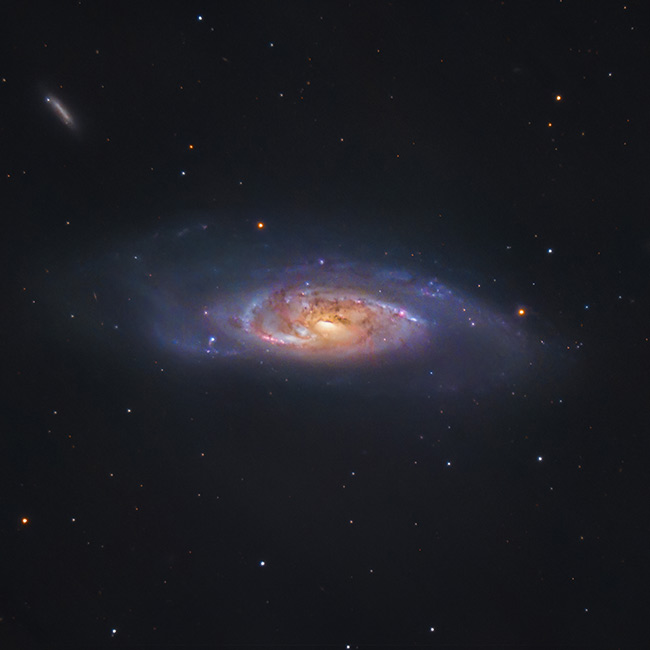The M106 Galaxy in Canes Venatici
The M106 Galaxy (also known as NGC 4258) is an intermediate spiral galaxy located in the northern constellation Canes Venatici. This galaxy lies approximately 23 million light-years away from Earth.
In the amateur astrophotography image below, you can see the gas and dust of the spiral arms spreading outward from the core of the galaxy. You can also see the dwarf galaxy NGC 4248 in the upper left of the image.
This image was captured using a Canon EOS Ra camera and a Celestron Edge HD 11 telescope. The image includes over 8 hours of total exposure time.
M106 in Canes Venatici. Photo by Trevor Jones.
An interesting fact about M106, is that it is the nearest Seyfert galaxy to Earth. A Seyfert galaxy includes an actively growing supermassive black hole.
M106 Galaxy
Messier 106 is similar in size and brightness to the great Andromeda Galaxy, but it lies 10 times farther away from Earth than M31 does. This spiral galaxy measures more than 130 thousand light-years across.
This remarkable image of M106 captured using the Nicholas U. Mayall 4-Meter Telescope on Kitt Peak National Observatory shows the warped central disk of M106, as well as the faint outer regions of the galaxy.
- Type: Intermediate Spiral Galaxy
- Cataloged: M106, NGC 4258
- Constellation: Canes Venatici
- Distance: 23.5 million light-years
- Magnitude: 8.4
- Apparent Size (V): 18′.6 × 7′.2
M106 was discovered in 1781 by Pierre Méchain in July 1781, describing this galaxy in sparse detail. In March of 1788, it was rediscovered by William Herschel using a better telescope. Herschel was able to see much more detail in Messier 106 and noted it as having a bright nucleus and faint “milky” branches to the north and south of the object.
M106 is not one of Charles Messier’s original catalog entries. The galaxy was added in 1947 by Helen Sawyer Hogg along with Messier 105 and Messier 107.
From mid-northern latitudes, the best time to observe M106 is in the spring (often referred to as ‘galaxy season‘). Late March to Early June is an ideal time to point your telescope toward this galaxy. It’s a difficult object to observe from southern latitudes, as it does not rise very high above the northern horizon.
Where is M106 Located?
M106 is located in the small northern cancellation Canes Venatici, bordering on Ursa Major. You may find it easiest to find this galaxy by star-hopping over from Merak in the Big Dipper asterism.
The location of the M106 galaxy in the night sky. Image created using Stellarium.
Astrophotography
As with many broad-spectrum deep space objects (such as galaxies and reflection nebula), M106 can be a difficult target to capture from a light-polluted location. A light pollution filter may help, but this will alter the color balance of the image and it will need to be corrected in post.
This spiral galaxy is also rather small, so a short focal-length refractor telescope likely won’t have enough reach to collect an image that includes the fine details near the core and outer arms of this galaxy. My latest attempt uses an SCT (Schmidt-Cassegrain Telescope) with a focal length of about 2000mm.
In the following video, I photograph the M106 Galaxy using a medium-sized refractor telescope.

